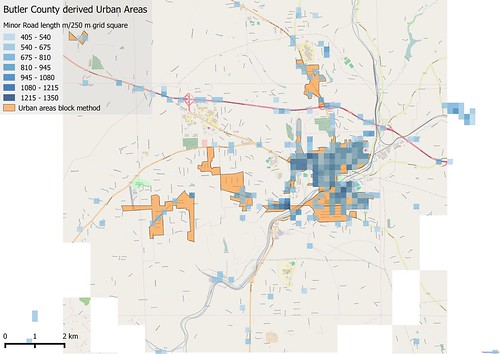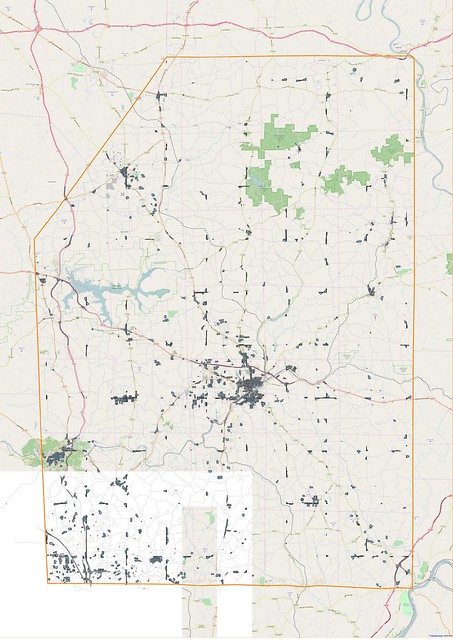 | |
| Comparison of Urban Areas derived using "block method" and gridded road density. Only grid squares with over 500 m of road included. The area shown is around Butler, Butler Co, PA |
Sunday 15 November 2015
Urban Areas 4 : Derivation from OpenStreetMap using road density
Another variation on the theme from the last post: this time looking for some measure of road density.
The easiest way is to sum road lengths in individual cells. The cells have to be quite small (say 250 metre square) to achieve the resolution desired. I've excluded link roads and motorway & trunk highway classed in this calculation.
Saturday 14 November 2015
Urban Areas 3 : derivation from OSM using residential blocks
 |
| View S from the Cathedral of Learning in Oakland, Pittsburgh, showing some urban areas used as tests in this post.
The incised valley of the Monogahela in the background contained railways and steel works. The plateau beyond has residential suburbs of Pittsburgh. To the left foreground are the woods and ravines of Schenley Park, with a residential area beyond. Source: Zack Weinberg via Wikimedia Commons CC-BY-SA
|
One of the obvious features of the highway network for the USA on OpenStreetMap is that road density is much higher in built-up areas. I started looking at how to measure this, when I recalled a method for identifying city blocks introduced to me by a Brazilian user of OpenStreetMap data.
 |
| Residential Areas for Butler Co, Pennsylvania, identified with the block method from OpenStreetMap data. Orange line outlines Butler County. |
The method itself is also really quite simple:
- Take the main road network for some area and make a union of it (which will be a MULTILINESTRING).
- Polygonize this data, and decompose to individual polygons.
Thursday 12 November 2015
Urban Areas 2 : Derivation from OpenStreetMap using Residential Roads
 |
| Street corner, Retiro, Buenos Aires (Libertad/ Juncal) CC-BY-SA, the author |
 |
| Buenos Aires and hinterland, showing comparison between urban polygons derived from OSM (green) and the Natural Earth data (light brown). |
I have chosen the following places as suitable test areas for these investigations:
- East Midlands of England. Not only my home turf, but also a well-mapped area with extensive use of landuse tags, and in excess of 99% of all residential roads. In addition Ordnance Survey Meridian 2 Open Data contains a layer corresponding to urban areas which provides an excellent control for checking results from this area.
- Pakistan. Not only one of the most populous countries in the world, but one of the least well mapped in OpenStreetMap. Pakistan is a likely candidate for cities which are barely mapped. I would also expect other very populous Asian countries (notably China, India and Bangladesh) which are poorly mapped to be similar to Pakistan.
- Nigeria. Similar criteria to Pakistan: the most populous country in Africa. The .pbf file for Nigeria is approximately 50% larger than that for Pakistan, but both are smaller than that for Lesotho with a population of 2 million compared to 180 million (Nigeria) and 200 million (Pakistan).
- Côte d'Ivoire. Close to Nigeria, but a place which I know has an active OSM community. Quite a number of mapping activities. (Note to Geofabrik, it's not called the Ivory Coast any more).
- Argentina. Latin American cities are often laid out in a grid, nowhere more so than in Argentina. The prevalence of the grid system, and my believe that the urban road system is largely complete were reasons for choosing this as a Latin American example. My own experience of travelling in Argentina after SotM-14 suggests that, for the most part, urban road systems are mapped. One known gap, the newer western suburbs of Ushuaia has recently been rectified by the kind provision of aerial imagery from the Argentine National mapping agency.
- Pennsylvania. It was essential to include some US data because of the TIGER import problem: all rural roads being tagged residential. Since I spent part of my childhood in Pennsylvania it is also a place I know and which I have edited (sporadically) to improve the rural road network.
Subscribe to:
Posts (Atom)